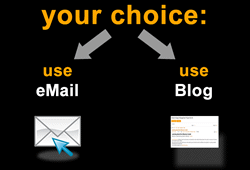
Blog versus eMail for Communication
Infographics are a great way to tell a story and explain how things work togehter (or not). „Gartner“ say’s that 80% of companies will fail their Social Business goals by 2015 by the reason „CEO commitment“. But why would they not want their people to work smarter?
In my eyes it is like when Internet came up – everyone had the feeling „we need it“ – but only very little had a vision, an idea or even a clear example, what the benefits are.
So it is not on the CEOs – it is on the „early adopters“, consultants and experts to SHOW the VALUE of using social business.
Well here is my contribution in one example – and please don’t judge me on my poor „infographic skills“ – it is my first one 😉

Now I would love to get your opinion of course – is this convincing, or not „good enough“, not relevant….
and yes, there is quite some other things to keep in mind and learn – as I mentioned it is „one“ example and it needs a strategy and a network of great people as role models… but I think this is another story 😉

Schreibe einen Kommentar